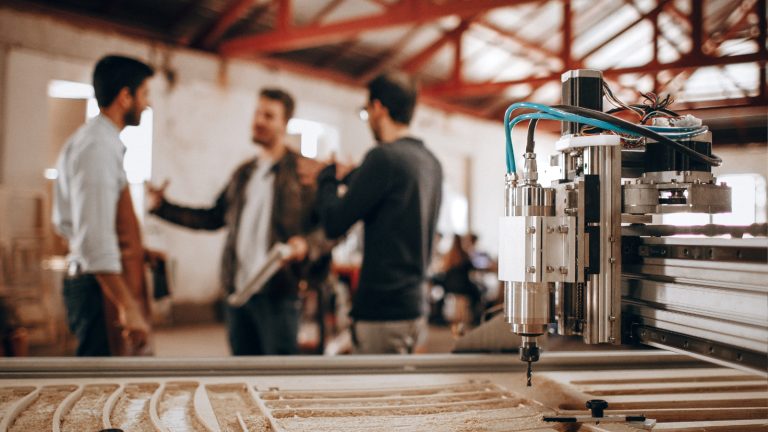Did you know that the design you receive today from the design department can ruin your manufacturing business tomorrow if it does not adhere to your company’s capabilities? This is why the ‘design’ itself gives so much value to the manufacturing industry, making it the root for success or failure. DFM, or Design for Manufacturing, is a much-talked-about topic in today’s world as the first step to product development. However, it is not always easy to be certain which DFM you must go with to save money, reduce delays and make the process faster.
In this article, we cover the eight principles that a designer must consider when producing a design for manufacturing.
What is Design for Manufacturing?

- DFM is the concept that revolves around producing goods spending the least amount of money, yet not compromising on their usefulness or the quality in any way. In other words, this indicates that DFM is the mechanism by which manufacturers create useful products by keeping expenses as low as possible, without compromising the quality and long-term dependability.
- Design for manufacturing is essential for manufacturing. When they keep processing, the manufacturers need to minimise the complexity of the workflow and reduce the material waste. On the other hand, they are supposed to come up with high-quality productions. In order to fulfil all of these expectations, optimising DFM is the initial point of execution.
- When Effective DFM is in place in manufacturing, various operations are included in the overall mechanism, such as different assessments for diverse products and production processes. This implies the diverse frameworks, such as checking on tight tolerances, cooling times for moulded parts, material type, machine selection, etc.
8 Principles of Creating a Design for Manufacturing

Minimise the Number of Parts
The rule of thumb in the DFM process highlights the importance of keeping the number of parts as low as possible. Whenever manufacturers add some additional parts, it puts a weight on aspects such as cost, weight, and the chance of failure. If they can flow with a minimal number of parts, that is the best way to make the product easier to put together. This will undoubtedly save both time and labour.
In another way, it takes the complexity out of the manufacturing architecture since this simply reduces the need for extra tools or fasteners. Therefore, it is a versatile strategy to decrease the number of parts, as that helps build stronger, cheaper, and more reliable products in the end. Such products are easy to maintain and repair when necessary.
Standardise Parts and Materials
If the manufacturers tend to utilise standard parts and materials, this will make the whole process of manufacturing faster, cheaper, and less stressful. Since these standardised components are high on availability, when producing custom orders, manufacturers can easily reduce waiting time and avoid expensive special designs. For example, if it is possible to go with a common screw size instead of a specially manufactured one, the vendors will deliver them faster and at a lower cost.
Plus, the standardised materials boost product compatibility, which makes repairs and upgrades simpler. It will save money as well as support the manufacturers with quick responses to market demands.
Design for Ease of Fabrication
Since there can be boundaries to the manufacturing capacity, a good product design should always match the abilities of the manufacturing process. This means whenever they opt for complex shapes or hard-to-cut materials, the costs will skyrocket and the production will surely get delayed.
It is visible that the materials that are easy to machine, mould, or weld make the way for saving money and reducing waste. This is why the designers should be mindful of the product designs and they should not make them unnecessarily complicated.
Use Modular Design
Modular design is the process of creating products from smaller sections, or modules. The speciality of such designs is that it is possible to make and test them separately. Since the manufacturers can build the modules separately at the same time and join them together, the whole production ecosystem is flexible. Even when repairing them, no need to replace the whole product; instead, they can separate the specific module and repair it.
Modular design is a commonly used way to update products faster, as it requires only changing one part. Since it offers easier maintenance, this approach saves time, reduces cost, and improves customer satisfaction.
Design for Efficient Assembly
When designing products, the major concern should be efficient assembly. What does this mean? This specifies the capacity to handle, orient and fit each part only with a little effort. However, as much as it reduces assembly time, it must avoid mistakes. The theory denotes that the lightweight and easy-to-grip parts help reduce worker fatigue. It is easier when the automated assembly machines are in function as they work well with simpler and predictable designs.
The best benefits of efficient assembly range from low labour costs, improved production speed, and reduction of errors, to smoother manufacturing procedures.
Minimise Reorientation during Manufacturing and Assembly
In the circumstances where a product is assembled or produced, the manufacturers must rotate, flip, or reposition them in order to come up with the final orientation of the production. This does not come cheaply as it requires extra time and money. Reorienting is a process that increases the chance of mistakes and can cause wear on machines.
This is why the singular orientation of parts is ideal, as it reduces the frequency of most machining and assembly steps. If they can keep the reorientation at minimal levels, the manufacturers can save time, reduce labour, and keep the production process smoother and the consistent product quality.
Design for Appropriate Tolerances
When it comes to design tolerance, it talks about how much a part’s size and shape can differ according to the design. Strict or loose tolerances equally negatively impact the design in the end. This means that when the design expresses strict tolerance, it may require expensive machines and slow processes, driving up costs. On the other hand, a very low level of tolerance will end up making the product unreliable.
This is where manufacturers must seek a balanced approach to ensure that tolerances match the capabilities of the chosen manufacturing method.
Design to Avoid Unnecessary Complexity
As a manufacturer, you may consider complex designs the most desirable. Yet, the truth is a different story. Such complicated designs tend to be problematic on the production floors. Think about those extra curves, features that the naked eye cannot capture; uncommon shapes can be impressive when considering a manufacturing designer’s capacity. However, they create challenges such as extra production time and high costs.
Not only that, but it will also be challenging for the assembly line and the maintenance. In order to avoid the latter, designers for manufacturing must present designs that are rich in simplicity, straightforward shapes, to gain maximum functionality of the final production. With reduced complexity, the manufacturers can offer easier-to-build, reliable performance and cheaper maintenance products at the same time.
Cerexio Digital Twin System for The Best Manufacturing Design

Since it is quite challenging for manufacturers to identify which design will offer the best outcome, the Cerexio Digital Twin System comes into play as the best solution. With its virtual representation, prototype abilities, and digital testing powers, the manufacturers can look into the functionalities of proposed designs in the digital space before selecting the precise one. With the Cerexio solution, Design for Manufacturing is no longer a complex decision.
Balancing Out Innovation with Cost-Savings in DFM

It is not a myth that simplicity works the best when it comes to productions. DFM is one such realm that proves this theory. However, this does not mean that your design teams should prevent presenting top-notch innovations, thinking that they will absorb a whole lot of money. If it is an outstanding DFM process, it must strike the right balance between innovation and cost savings. Make technology a bridge between these two aspects today.
FAQ about Design for Manufacturing
Design for Manufacturing (DFM) comes with an important part of it, which is prototypes. This involves transfiguring a design concept into a physical object. It helps the designers to check whether the idea would be practical in real-world scenarios.
At an initial discussion, the procedures available for producing a product are discussed in order to solve any production issues. The sequence in which it is constructed, the automations that are accessible, the possible manufacturing methods, and the factors that contribute to its increasing or decreasing cost.
The primary difference between DFA and DFM is that DFA concentrates on assembly process optimisation, whereas DFM concentrates on manufacturing process optimisation. DFA’s primary goal is to cut down on the number of assembly processes and the amount of time needed for each one.
